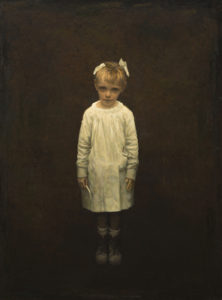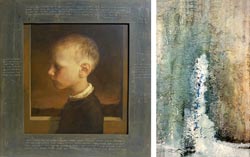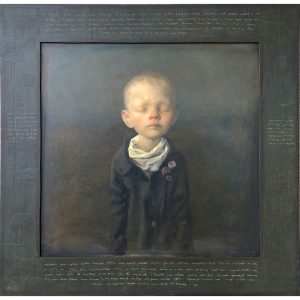October 4 – 28, 2019 | Igor Melnikov: Soulscapes
Igor Melnikov’s art defies easy classification. The Russian-born artist resists labels like Figure Painter or Symbolist, insisting that his depictions of physical objects serve as realistic presentations of ideas, rather than coded iconography. His subdued paintings, with their detailed depictions of people and things, are not the work of a stereotypical contemporary Conceptual artist either. Instead, Melnikov places himself in a more ambiguous territory: somewhere between traditional and conceptual, paying homage to both the technical mastery of Old Masters and the psychological subjectivity of more modern artists.
Melnikov’s duality as a traditional and conceptual artist gains clarity when examined against the restrictive backdrop of his upbringing in the Soviet Union. Born in Moscow in 1956, Melnikov’s early sense of the global art world was limited to black-and-white reproductions of great artworks, as the Communist party heavily censored the flow of international art. At 15, he enrolled at the Moscow Art Performance School. Even at an arts school, though, the global art world remained remote, as Melnikov learned a technique-centric, traditional Russian artistic style. By the time Melnikov and his fellow young Russian artists had conceived of seemingly novel ideas, they often found that their same tactics had already been employed elsewhere. They feared accidental plagiarism, so they looked for inspiration in unlikely places: as Melnikov put it, “junkyards were the Disneylands of our childhood.”
Opening Reception Friday, October 4, 2019 from 5 to 7pm.
November 17 – 30, 2017 | Igor Melnikov: The Human Vessel

Igor Melnikov – Girl with Note
Russian artist Igor Melnikov is one of the top artists to emerge from the post-Soviet Russian art world. Unlike more opportunistic Russian artists who sought to make artwork that would appeal to the Western art collector, Melnikov has always remained true to his intimate belief in art as a spiritual practice.
Melnikov grew up fairly isolated in Siberia, where his mother was a scientist. His own childhood was spent largely in isolation, so he views the inner world of the child as the most pure vessel of humanity.
Contrary to what appears to be figurative painting at first glance, Melnikov views his own work as conceptual art. He presents the pure human vessel, in the form of the expressionless, innocent child; allowing the viewer to fill that vessel with meaning as they ponder the work.
Opening Reception Friday, November 17, 2017 from 5 to 7pm
[n.b. that this event takes place in Santa Fe]
November 1 – 22, 2016 | Igor Melnikov and Edward Lentsch: Expansion Theory

Expansion Theory
Igor Melnikov’s and Edward Lentsch’s paintings share an ability to speak directly to the human psyche. Melnikov places the human child in his otherwise minimal paintings, with blessings scrawled in undecipherable Russian on the frames that surround and protect them. Melnikov considers himself a conceptual, rather than a narrative artist. He attempts to present an image we all recognize—the child—one with which we have no negative associations.
He considers the child to be the vessel for the human spirit, from which the viewer can taste the essence that binds us all together. Edward Lentsch approaches painting in a manner of primordial creation. He mixes earth, raw pigment, and other natural materials to create the atmosphere of the cosmos. It is possible to explore each of these artists’ works for extended amounts of time. Like the mind enters Melnikov’s paintings through the eyes of the children, the space and texture of Lentsch’s paintings allow the eye to meander in the sublime beauty of one’s inner world.
Opening Reception Friday, November 4, 2016 from 5 to 7pm
[n.b. that this event takes place in Santa Fe]
Oct 25, 2013 | Mutual Art

Igor Melnikov
New work from Igor Melnikov is dedicated to his “principal of simplicity.” “For Melnikov the work has no relevance if analysis is essential to the embracing and understanding of his paintings. The images must permeate that emotional core of our very being and transport the viewer to a place where logic cannot explain the experience before them.” This new body of work contains elements of departure from previous exhibitions, and needs to be seen by anyone interested in “the deep reach

